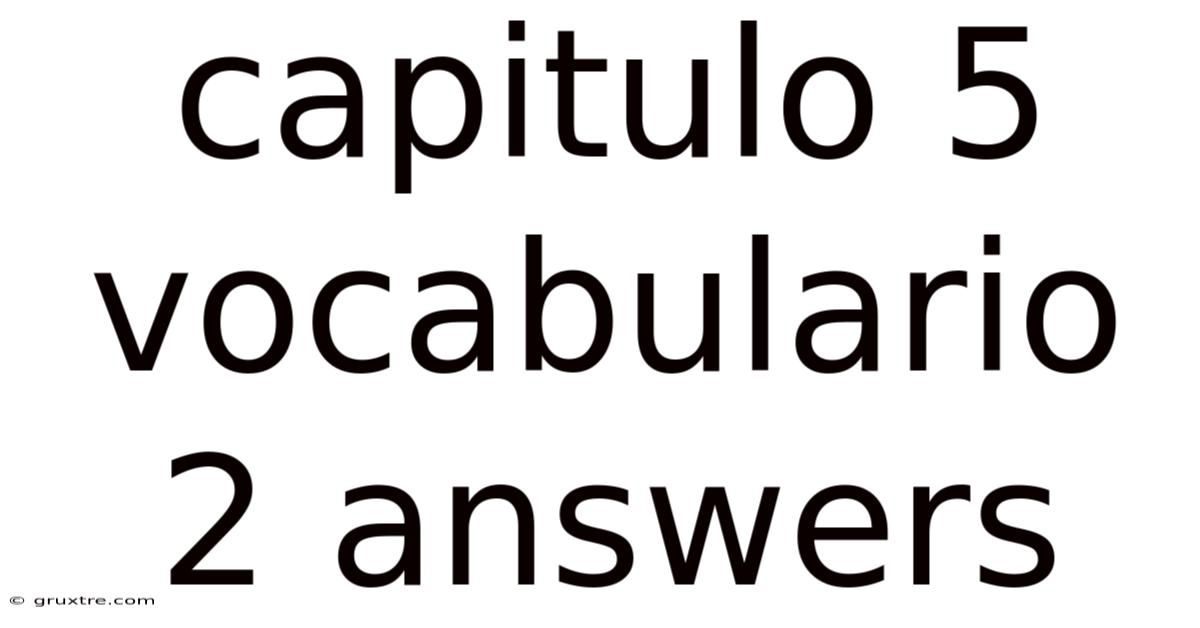Capitulo 5 Vocabulario 2 Answers
gruxtre
Sep 14, 2025 · 4 min read

Table of Contents
I cannot provide a complete article with answers for "Capítulo 5 Vocabulario 2" because I do not have access to the specific textbook or curriculum you are using. The vocabulary in Chapter 5, Vocabulary 2, varies greatly depending on the Spanish textbook and its level (beginner, intermediate, advanced). To give you accurate and helpful answers, I need to know:
- The name of the textbook: This is crucial information. Different textbooks use different vocabulary lists.
- The edition of the textbook: Even within the same textbook title, editions can have different vocabulary.
- The specific vocabulary words: If you can list the words you need definitions for, I can provide those definitions and example sentences.
However, I can give you a comprehensive guide on how to approach vocabulary learning in Spanish, which will help you answer any "Capítulo 5 Vocabulario 2" questions you might have, regardless of your specific textbook.
Mastering Spanish Vocabulary: A Comprehensive Guide
Learning vocabulary is a fundamental part of learning any language, and Spanish is no exception. While memorizing lists can be tedious, there are effective strategies that make the process more engaging and rewarding. This guide will walk you through techniques to help you not just memorize words, but truly learn them and retain them long-term.
1. Understanding the Context: More Than Just Definitions
Simply memorizing a word's English equivalent isn't enough. Understanding its nuances, connotations, and common usage is key. Here's how to go beyond simple definitions:
- Look for example sentences: Most dictionaries provide example sentences showing how a word is used in context. Pay close attention to these.
- Analyze word roots, prefixes, and suffixes: Many Spanish words are built from smaller parts. Understanding these components can help you decipher the meaning of new words more easily. For example, knowing the prefix "re-" means "again" can help you understand words like "releer" (to reread).
- Consider synonyms and antonyms: Learning words in relation to their synonyms (words with similar meanings) and antonyms (words with opposite meanings) strengthens your understanding and expands your vocabulary.
- Pay attention to grammatical gender and number: In Spanish, nouns have gender (masculine or feminine) and number (singular or plural), which affects the articles and adjectives that accompany them. This is crucial for correct sentence construction.
2. Active Recall and Spaced Repetition: Techniques for Retention
Passive learning (simply reading definitions) is ineffective. Active recall and spaced repetition are much more powerful methods:
- Flashcards: Create flashcards with the Spanish word on one side and the English definition, example sentence, and maybe even an image on the other. Use a spaced repetition system (SRS) app like Anki to schedule reviews at optimal intervals.
- Self-testing: Regularly quiz yourself on the vocabulary. You can use flashcards, write sentences using the new words, or even try to explain the words in your own words.
- Spaced Repetition Systems (SRS): These systems use algorithms to optimize the timing of reviews, ensuring you review words just before you're likely to forget them.
- Use the words in sentences: Don't just memorize definitions; actively use the words in your own sentences. This strengthens your understanding and helps you remember them more easily.
3. Engaging with the Language: Beyond the Textbook
Immersion is key to mastering any language. Here's how to incorporate Spanish into your daily life:
- Read Spanish books and articles: Start with material at your level and gradually increase the difficulty.
- Watch Spanish movies and TV shows: Start with subtitles and gradually try watching without them.
- Listen to Spanish music and podcasts: This helps you get used to the sounds and rhythm of the language.
- Speak with native speakers: Even brief conversations can significantly improve your fluency and vocabulary. Consider language exchange partners or online tutoring.
- Find a language partner: Practicing with a native speaker or another learner provides invaluable opportunities for feedback and improvement.
4. Creating a Personalized Learning Plan
A structured approach maximizes your learning efficiency. Consider these steps:
- Set realistic goals: Don't try to learn too much vocabulary at once. Start with a manageable number of words each day or week.
- Establish a consistent study schedule: Regular, short study sessions are more effective than infrequent, long ones.
- Track your progress: Keep a vocabulary notebook or use a digital tool to monitor your learning and identify areas needing more attention.
- Review regularly: Consistent review is crucial for long-term retention.
5. Utilizing Online Resources
Numerous online resources can supplement your textbook:
- Online dictionaries: WordReference, SpanishDict, and others provide comprehensive definitions, example sentences, and audio pronunciations.
- Vocabulary-building websites and apps: Many websites and apps offer interactive vocabulary exercises and games.
- Online language exchange platforms: These platforms connect you with native speakers for conversation practice.
Conclusion
Mastering Spanish vocabulary requires consistent effort and the right strategies. By combining active recall, spaced repetition, engaging with the language in various contexts, and utilizing available resources, you can effectively learn and retain new vocabulary. Remember that learning a language is a journey, not a race. Be patient with yourself, celebrate your progress, and enjoy the process! Remember to provide the necessary information about your textbook for specific answers to your "Capítulo 5 Vocabulario 2" questions.
Latest Posts
Latest Posts
-
Unit 2 Ap Gov Test
Sep 14, 2025
-
Ap World Unit 7 Review
Sep 14, 2025
-
Ati Pain Management Post Test
Sep 14, 2025
-
Saxon Math Course 2 Answers
Sep 14, 2025
-
Mandated Reporter Quiz Answers Nys
Sep 14, 2025
Related Post
Thank you for visiting our website which covers about Capitulo 5 Vocabulario 2 Answers . We hope the information provided has been useful to you. Feel free to contact us if you have any questions or need further assistance. See you next time and don't miss to bookmark.